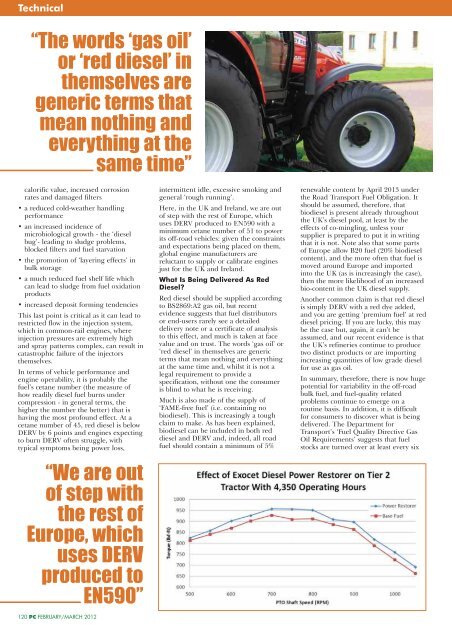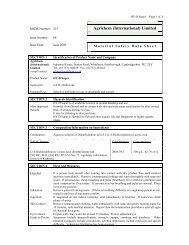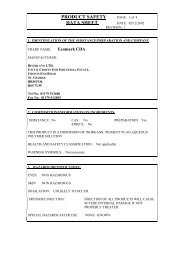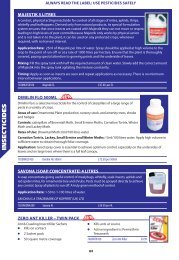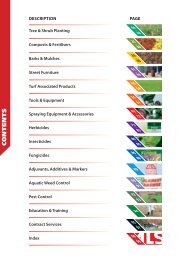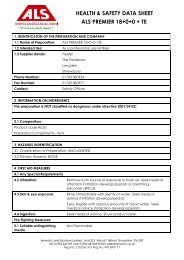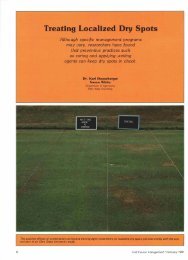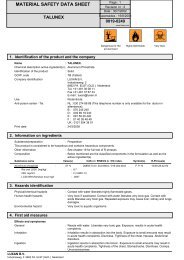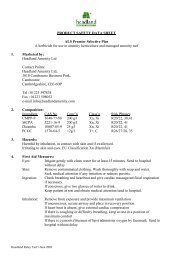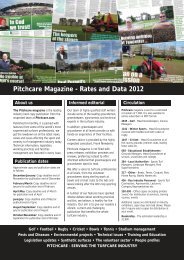these Open Championship Clubs choose to relief grind - Pitchcare
these Open Championship Clubs choose to relief grind - Pitchcare
these Open Championship Clubs choose to relief grind - Pitchcare
Create successful ePaper yourself
Turn your PDF publications into a flip-book with our unique Google optimized e-Paper software.
Technical<br />
“The words ‘gas oil’<br />
or ‘red diesel’ in<br />
themselves are<br />
generic terms that<br />
mean nothing and<br />
everything at the<br />
same time”<br />
calorific value, increased corrosion<br />
rates and damaged filters<br />
• a reduced cold-weather handling<br />
performance<br />
• an increased incidence of<br />
microbiological growth - the ‘diesel<br />
bug’- leading <strong>to</strong> sludge problems,<br />
blocked filters and fuel starvation<br />
• the promotion of ‘layering effects’ in<br />
bulk s<strong>to</strong>rage<br />
• a much reduced fuel shelf life which<br />
can lead <strong>to</strong> sludge from fuel oxidation<br />
products<br />
• increased deposit forming tendencies<br />
This last point is critical as it can lead <strong>to</strong><br />
restricted flow in the injection system,<br />
which in common-rail engines, where<br />
injection pressures are extremely high<br />
and spray patterns complex, can result in<br />
catastrophic failure of the injec<strong>to</strong>rs<br />
themselves.<br />
In terms of vehicle performance and<br />
engine operability, it is probably the<br />
fuel’s cetane number (the measure of<br />
how readily diesel fuel burns under<br />
compression - in general terms, the<br />
higher the number the better) that is<br />
having the most profound effect. At a<br />
cetane number of 45, red diesel is below<br />
DERV by 6 points and engines expecting<br />
<strong>to</strong> burn DERV often struggle, with<br />
typical symp<strong>to</strong>ms being power loss,<br />
“We are out<br />
of step with<br />
the rest of<br />
Europe, which<br />
uses DERV<br />
produced <strong>to</strong><br />
EN590”<br />
120 PC FEBRUARY/MARCH 2012<br />
intermittent idle, excessive smoking and<br />
general ‘rough running’.<br />
Here, in the UK and Ireland, we are out<br />
of step with the rest of Europe, which<br />
uses DERV produced <strong>to</strong> EN590 with a<br />
minimum cetane number of 51 <strong>to</strong> power<br />
its off-road vehicles: given the constraints<br />
and expectations being placed on them,<br />
global engine manufacturers are<br />
reluctant <strong>to</strong> supply or calibrate engines<br />
just for the UK and Ireland.<br />
What Is Being Delivered As Red<br />
Diesel?<br />
Red diesel should be supplied according<br />
<strong>to</strong> BS2869:A2 gas oil, but recent<br />
evidence suggests that fuel distribu<strong>to</strong>rs<br />
or end-users rarely see a detailed<br />
delivery note or a certificate of analysis<br />
<strong>to</strong> this effect, and much is taken at face<br />
value and on trust. The words ‘gas oil’ or<br />
‘red diesel’ in themselves are generic<br />
terms that mean nothing and everything<br />
at the same time and, whilst it is not a<br />
legal requirement <strong>to</strong> provide a<br />
specification, without one the consumer<br />
is blind <strong>to</strong> what he is receiving.<br />
Much is also made of the supply of<br />
‘FAME-free fuel’ (i.e. containing no<br />
biodiesel). This is increasingly a <strong>to</strong>ugh<br />
claim <strong>to</strong> make. As has been explained,<br />
biodiesel can be included in both red<br />
diesel and DERV and, indeed, all road<br />
fuel should contain a minimum of 5%<br />
renewable content by April 2013 under<br />
the Road Transport Fuel Obligation. It<br />
should be assumed, therefore, that<br />
biodiesel is present already throughout<br />
the UK’s diesel pool, at least by the<br />
effects of co-mingling, unless your<br />
supplier is prepared <strong>to</strong> put it in writing<br />
that it is not. Note also that some parts<br />
of Europe allow B20 fuel (20% biodiesel<br />
content), and the more often that fuel is<br />
moved around Europe and imported<br />
in<strong>to</strong> the UK (as is increasingly the case),<br />
then the more likelihood of an increased<br />
bio-content in the UK diesel supply.<br />
Another common claim is that red diesel<br />
is simply DERV with a red dye added,<br />
and you are getting ‘premium fuel’ at red<br />
diesel pricing. If you are lucky, this may<br />
be the case but, again, it can’t be<br />
assumed, and our recent evidence is that<br />
the UK’s refineries continue <strong>to</strong> produce<br />
two distinct products or are importing<br />
increasing quantities of low grade diesel<br />
for use as gas oil.<br />
In summary, therefore, there is now huge<br />
potential for variability in the off-road<br />
bulk fuel, and fuel-quality related<br />
problems continue <strong>to</strong> emerge on a<br />
routine basis. In addition, it is difficult<br />
for consumers <strong>to</strong> discover what is being<br />
delivered. The Department for<br />
Transport’s ‘Fuel Quality Directive Gas<br />
Oil Requirements’ suggests that fuel<br />
s<strong>to</strong>cks are turned over at least every six


